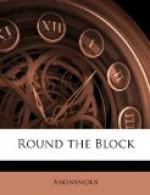Bog, before leaving his shop, had been provided with this decoy note, written by the ingenious Wesley Tiffles in cunning imitation of Miss Minford’s handwriting. The long, elegant curves, and all the delicate peculiarities of her chirography, taught by Miss Pillbody, had been copied from the sample furnished by her note to Mrs. Crull. It ran as follows:
MR. VAN QUINTEM:
DEAR SIR: Come to me at once, for I am in trouble.
PET.
The plan (Bog’s contrivance all this) was to inquire at the gambling houses where Mr. Van Quintem, jr., was most likely to be, and, when he was found, to send this note in to him by a servant. Bog, having delivered the note, was to withdraw to the sidewalk, lie in ambush, till young Van Quintem came out, and then follow him to Miss Minford’s retreat. There he was to wait, and send a swift messenger to Mrs. Crull and old Van Quintem. It was not known that young Van Quintem had ever seen Miss Minford’s handwriting; but, to make the game sure, the note had been written with a skill worthy of a counterfeiter, or that most dexterous of penmen, young Van Quintem himself.
Bog commenced operations about three o’clock in the afternoon—the hour when the gambler and debauchee, who have been up all the previous night, are ready to begin their feverish life again.
He first visited a snug establishment near the lower end of Broadway. It was situated in the second story, over a nominal exchange office, and was the favorite resort of down-town brokers, who, having gambled on Wall street till the close of business hours, dropped in to flirt with Fortune an hour or two before going home to dinner. Sometimes their hour or two was protracted to six o’clock next morning, when they staggered home to breakfast and a curtain lecture together. This Temple of Faro was never impertinently molested by the police; and it was a subject of remark, among people who thought they had been robbed there, that there was never a policeman within sight of the door.
In the hallway of the second story occupied by this gambling saloon, were a number of doors, which the experienced eye of the boy at once decided to be blinds, or, in other words, no doors at all, but only imitations. The appearance of the second story was that of a suite of unoccupied offices. Whoever rapped at these blind doors, could obtain no admission.
At the end of the hallway, Bog came upon a long window, which was painted white on the inside. He saw, by a glance at the grooves of the lower sash, that it was often raised. There was a boot-worn hollow on the floor beneath the window. The unusual length of the lower sash, and the nearness of the sill to the floor, would permit persons to step into the room easily when the window was raised.
Bog rapped thrice at this window. He had a vague idea—derived from reading, perhaps—that three raps were an open sesame to mysterious rooms the world over. The last rap had not ceased to vibrate on the pane of glass, when the window was suddenly shoved up, as if by somebody waiting on the other side.




